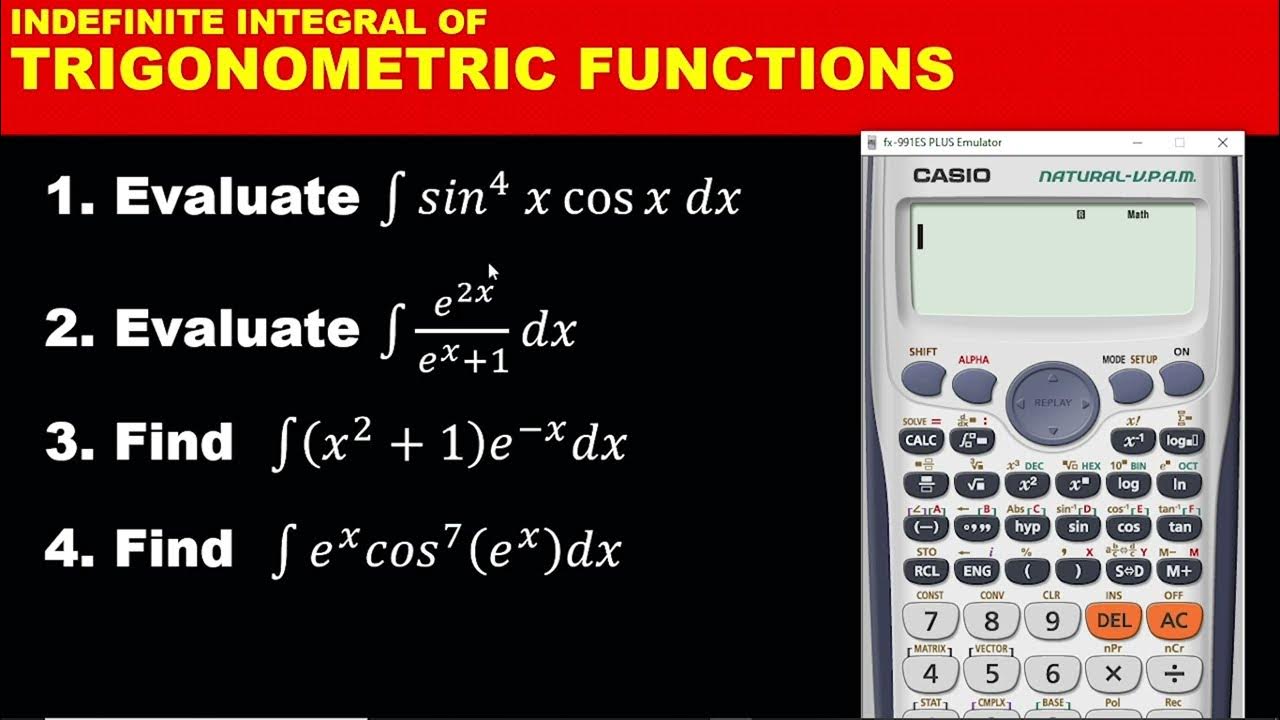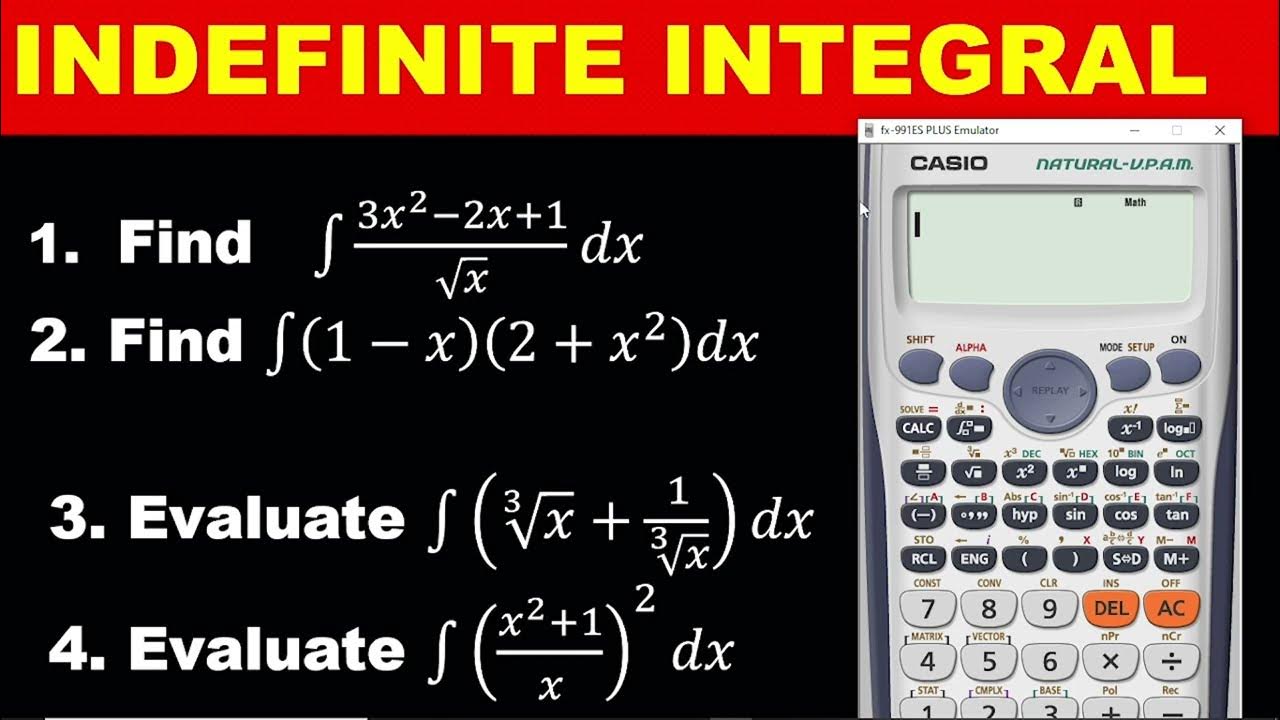How to use Calculator for Evaluate Multiple Integrals - Easy Techniques
TLDRThis instructional video teaches viewers how to use a calculator to compute double and triple integrals. The presenter first outlines key rules, such as replacing 'y' with 'x' and 'dy' with 'dx', to adapt the calculator for integral calculations. The video then demonstrates step-by-step solutions for given integral problems, showing how to break down complex integrals into simpler, separable parts that can be easily entered into a calculator. Examples include transforming the integral expressions and correctly setting the intervals for accurate computation. The presenter encourages practice to verify the calculator's results and emphasizes the utility of this method for solving integrals, especially during exams.
Takeaways
- 📚 The video is a tutorial on how to use a calculator to compute double and triple integrals within given intervals.
- 🔢 Before using the calculator, it's important to understand that the calculator functions in terms of 'x' and not 'y', hence 'y' terms are replaced with 'dx' and 'dy'.
- 📝 The process involves separating the integral into parts that can be calculated individually on the calculator.
- 📉 For double integrals, the 'y' is replaced with 'x' and the 'dy' with 'dx', and the integral is broken down into manageable parts.
- 📊 When dealing with multiplication in the integral, separate each term so they can be calculated sequentially on the calculator.
- 🔑 The first example provided demonstrates how to calculate an integral of a function involving y squared from 1 to 3 and x from 0 to 2, resulting in 52/3.
- 📚 The second, more complex example, involves breaking down the integral into two parts and using the calculator to find the solution.
- 📐 The third example introduces the concept of triple integrals, emphasizing the same principles of replacing variables and breaking down the integral.
- 📈 The triple integral example shows how to calculate an integral with z, x, and y variables, resulting in a final answer of 10/3.
- 👍 The presenter encourages viewers to verify calculator results by hand to ensure accuracy and understanding.
- 📲 The video concludes with a reminder to subscribe and like for more educational content, and mentions a description with manual calculation methods.
Q & A
What is the main topic of the video?
-The main topic of the video is teaching how to use a calculator to calculate double and triple integrals with given intervals.
Why is it necessary to replace 'y' with 'x' when using the calculator for integrals?
-It is necessary to replace 'y' with 'x' because calculators typically function or are manipulated to be in terms of 'x' but not 'y', making it essential to adapt the integral expressions accordingly.
What is the first rule mentioned for using a calculator to solve double integrals?
-The first rule mentioned is to replace all instances of 'y' with 'dx' on the calculator.
What is the second rule for using a calculator to solve double integrals?
-The second rule is to replace all instances of 'dy' with 's' on the calculator.
How does the video suggest breaking down a multiplication form integral for calculator use?
-The video suggests separating the integral into parts that can be individually calculated on the calculator, ensuring that each part is associated with the correct variable and interval.
What is the example given for the first integral calculation in the video?
-The example given is the calculation of the integral of y^2 from 1 to 3, which is manipulated to x^2 dx from 1 to 3 on the calculator.
How does the video demonstrate the process of solving a complex integral using a calculator?
-The video demonstrates by breaking down the complex integral into simpler parts, replacing 'y' with 'x', and then inputting the manipulated expressions into the calculator to find the solution.
What is the final answer obtained for the first integral example in the video?
-The final answer obtained for the first integral example is 52/3.
How does the video handle the transition from double to triple integrals in terms of calculator usage?
-The video emphasizes that the same principles apply, but with additional steps and variables, such as replacing 'z' with 'x' and adjusting for the new intervals associated with 'z'.
What is the final answer provided for the triple integral example in the video?
-The final answer provided for the triple integral example is 10/3.
Outlines
📚 Introduction to Calculator Use for Double and Triple Integrals
This paragraph introduces the concept of using a calculator to compute double and triple integrals with given intervals. The speaker emphasizes the importance of understanding the calculator's function and how to manipulate it for integral calculations. The first rule is to replace all instances of 'y' with 'dx' and 'dy', and the second rule is to ensure that the calculator is set to function in terms of 'x'. The paragraph provides a step-by-step guide on how to set up and solve a double integral problem using a calculator, including changing the integral expressions to match the calculator's format and solving the problem to obtain the answer 52/3.
🔍 Detailed Explanation of Double Integral Calculation with a Calculator
The second paragraph delves deeper into the process of calculating double integrals using a calculator. It explains the concept of breaking down the integral into separable parts and how to manipulate the integral sign to accommodate different terms. The speaker provides a specific example, showing how to separate the terms and replace 'y' with 'x' according to the established rules. The paragraph walks through the process of setting up the integral in the calculator, including inputting the correct intervals and functions, and obtaining the final answer. It also encourages viewers to verify the calculator's answer by solving the problem manually.
📘 Transition to Triple Integrals and Calculator Manipulation Techniques
The final paragraph transitions from double to triple integrals, emphasizing the same principles of calculator manipulation. It outlines the process of setting up triple integrals in the calculator, including replacing 'y' and 'z' with 'x' and adjusting the integral expressions accordingly. The speaker provides an example of a triple integral problem, detailing the steps to break it down and input it into the calculator. The paragraph concludes with a demonstration of how to use the calculator to solve the triple integral and obtain the result. The speaker also shares a personal anecdote about using these techniques during an exam, highlighting the practicality of the method.
Mindmap
Keywords
💡Double Integral
💡Triple Integral
💡Calculator
💡Separable
💡Interval
💡Manipulation
💡Multiplication
💡Integral Sign
💡Function
💡Volume
Highlights
Introduction to using a calculator for calculating double and triple integrals with given intervals.
Explanation of the rules for using the calculator in integral calculations, specifically replacing 'y' with 'dx' and 'dy' with 's'.
Demonstration of how to separate the integral into parts to make it suitable for calculator input.
Example of solving a multiplication form integral using the calculator by dividing it into separable parts.
Clarification on matching integral parts with their corresponding intervals and the importance of the order of operations.
Illustration of the process to input the integral into the calculator and the steps to follow for accurate calculation.
Explanation of how to handle integrals with multiple variables by replacing 'y' with 'x' and adjusting the intervals accordingly.
Presentation of a complex integral problem and the method to break it down for calculator use.
Guide on separating the integral into two parts and the significance of the double integral sign.
Detailed breakdown of a complex integral into simpler components for calculator input.
Instruction on how to input each part of the complex integral into the calculator and the importance of following the correct order.
Introduction to solving triple integrals with the calculator, emphasizing the same principles as double integrals.
Explanation of how to replace variables in triple integrals and the importance of maintaining the correct intervals.
Demonstration of the process to calculate a triple integral using the calculator, step by step.
Final exam experience sharing on how the calculator method helped in solving complex integral problems.
Conclusion and encouragement to practice using the calculator for integral calculations and to check answers manually.
Invitation to subscribe, like, and share the video for more educational content on calculus.
Transcripts
Browse More Related Video

Multiple Integrals Calculator Techniques - Engr. Yu Jei Abat | #AbatAndChill

Definite integrals (area under a curve) with GDC [IB Maths AI SL/HL]

INTEGRATION PART 2: CALCULATOR TECHNIQUES ON INDEFINITE INTEGRATION OF TRIGONOMETRIC FUNCTIONS

INTEGRATION PART 1: SIMPLE CALCULATOR TECHNIQUES FOR SOLVING INDEFINITE INTEGRAL- WASSCE MATHS

How to use calculator to solve Definite Integration Problems ft Casio FX 991ES

HOW TO DO INTEGRATION IN SCIENTIFIC CALCULATOR: Casio fx-991 es plus
5.0 / 5 (0 votes)
Thanks for rating: